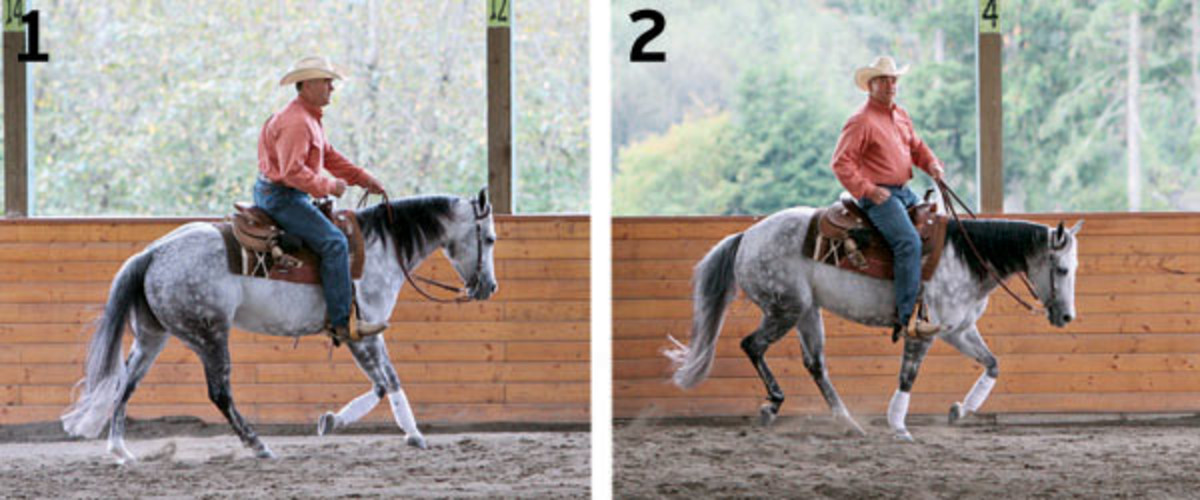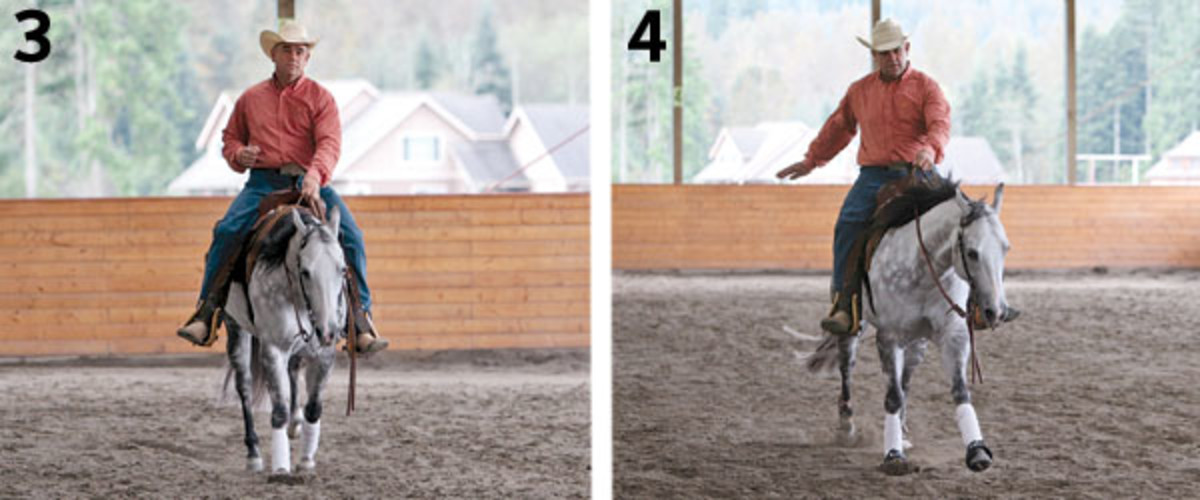Rundowns and run-in patterns in reining and the reined work in working cow horse can cause serious anxiety for horse and rider. They’re the preamble maneuver to something big—the sliding stop—so a lot rides on them in terms of setting your horse up.
While a little tension can hone focus, it also can cause you to stiffen and transfer your anxiety to your horse. When both of you tighten up and get worried, the rundown to the stop gets crooked, your horse bolts to a high speed rather than slowly building speed, and you brace against him. None of those traits make for a good stop.
Here I’ll go over tips you can use to work on keeping your cool during rundowns at home. The payoff: Your approaches, whether at the beginning of a run-in pattern or the end of a pattern, will set you up for solid stops.
1. Just as the rundown is an approach to a sliding stop, there’s an approach to a rundown: It occurs when you lope across the short end of the pen before turning to lope down the long side. Or, in a run-in pattern, the approach starts outside the gate. At this point, be very mindful of your breathing, and keep breathing all the way through to the stop. So much of what you communicate to your horse can get lost or muddled if you’re not breathing rhythmically, in and out. Holding your breath makes you tight, which makes your horse anxious. When you’re at home, consciously think about your breathing patterns, no matter where you’re riding, so that it becomes habit anywhere in the arena. Try breathing in rhythm with your horse; for example, at a lope, breathe in for two strides and out for two strides. It also helps to take a calming deep breath once you begin your rundown.

2. Before your horse makes the corner, look through your turn to go down the long fence. Find a spot at the far end of the arena that’ll be straight in front of you, and focus on that. Keeping your eyes up and maintaining your rhythmic breathing will help you feel more confident and focused. Furthermore, looking down the arena sets you up to stay straight as you build speed. At home, you can exaggerate your body position when you make the corner to begin your rundown, so your horse becomes in tune with your torso turning, your outside leg putting pressure on his side, and your outside rein touching his neck. That way, at the show, it’ll take a less-obvious cue for your horse to respond willingly.
3. As you lope on the straightaway, keep your eyes up and focused on your spot on the wall or arena fence. This is why I have numbers and signs at various points in my arena at home. They give me and my non-pro riders definitive spots to ride to. Furthermore, I suggest doing rundown-type maneuvers in all different spots in the arena, from one sign to another, at all different angles, to help keep your eyes up and your focus on straightness.

4. To bust tension at home or a schooling show, reach back and pat your horse on the rump as you lope down the long side of the arena. This forces you to relax and loosen your body. A tense lower back during a rundown leads to tension in the entire body. That means you can’t sit a stop as fluidly as you can with a soft back. That stiffness creates a stop that’s choppy, quick, and stiff on the front end. Patting your horse on the rump also let’s him know, “Hey, it’s OK. We don’t have to get all worked up loping a straight line from one end of the arena to the other.” When you do this, don’t ask the horse to build to full speed for a big stop. Instead, build a little, and then quietly stop your horse.
5. As you build speed, soften any tension in your back. Keeping your lower back soft allows you to better move with your horse—not to mention that then you don’t transfer your stiffness and anxiety to your horse.

6. Here’s what to aim for in a rundown: My back is soft, my hand is in the middle of my horse’s neck, and I’m breathing. This all means that my horse won’t get too strong as she approaches a sliding stop. Before I cue for the stop, I’ll count to three in time with her stride, creating a slight upward tempo as I build speed. I’ll take a deep, steady breath—not a big gasp for air, which could create tension—and I’ll let it out as I say “whoa” and sit deeply into my saddle for a straight, correct stop that was set up well, thanks to my rundown approach.
Darren Stancik trains reining horses from Sky River Equestrian Center in Sultan, Washington. Stancik is an AQHA world champion, an NRHA Futurity finalist, an NRHA judge, and a recognized pro at working with amateur riders. Learn more about him at stancik-qh.com.






